BOSTON — A waterfront building in Gloucester that has gone unused for years has reopened as a research station that officials hope will develop into a world leader in tracking the health of tuna and other large fish stocks while providing a boost to the local and state economies.
The Marine Science Research Station reopened today as a cooperative effort between the University of Massachusetts and the state Division of Marine Fisheries.
It now houses the Large Pelagics Research Center dedicated to the study of large fish, primarily the bluefin tuna that feed in the Gulf of Maine during the summer and fall.
Research by center director and UMass professor Molly Lutcavage involves tagging blue fin tuna with a satellite tracking device that pops off by itself after about a year without ever harming the fish. Once it pops off and floats to the ocean’s surface, it transmits data including the tuna’s migratory travels and depth, information that can be used to help manage resources.
Knowing where the tuna are, and how many there are, helps government managers prevent overfishing and keeps the fishery sustainable for future generations.
The technology has already shown that there is more mixing between the western Atlantic Bluefin population off the North American coast and the eastern Atlantic Bluefin found off Europe and North Africa than previously thought, Lutcavage said.
“What that showed is that the lack of management in the Mediterranean would impact the stocks in the U.S. and the Canada,” she said. “If you’re wiping out tuna in the east we won’t have sustainable fisheries in the west.”
The relationship between scientists and commercial fishermen can be acrimonious. But there is no such tension between Lutcavage and stakeholders in the industry that landed $470 million in seafood and supported 73,000 jobs in the state last year, said state Sen. Bruce Tarr, R-Gloucester.
“Molly has developed over the years a remarkable partnership with fishermen and that is not common in this age,” Tarr said.
Lutcavage says that’s because she does her research the old-fashioned way.
“We’re doing what the old timers used to do in fisheries science,” she said. “They were scientists who spent a lot of time on commercial boats and spoke a common language with fishermen.
“Fishermen trust us because we have shown that we can be objective and do a good job trying to portray what’s out there,” she said.
The six-acre site in Hodgkins Cove was originally used in the early 1900s to ship the granite carved out of nearby Rockport quarries. UMass-Amherst bought it in 1970 to serve as a seafood research laboratory. When the director of that lab died in 2007, the building fell into disuse.
A $400,000 renovation project has brought new life to the 3,200-square foot building. The renovations included a new floor and roof, rewiring, weatherproof windows and a new coat of paint.
Revitalizing what had become an eyesore became a personal goal for Tarr.
Currently, just a handful of people are working at the site, but Tarr envisions a time when dozens work in the building.
The research station is also expected to boost both the local commercial and recreational fishing industries because a better idea of where the tuna swim helps the recreational industry by bringing in fishermen who stay in local hotels, eat in local restaurants and buy their tackle at local stores.
Lutcavage envisions a marine research hub much like Woods Hole on Cape Cod.
“This is a phenomenal location for a marine scientist,” she said.
Copy the Story LinkSend questions/comments to the editors.



Success. Please wait for the page to reload. If the page does not reload within 5 seconds, please refresh the page.
Enter your email and password to access comments.
Hi, to comment on stories you must . This profile is in addition to your subscription and website login.
Already have a commenting profile? .
Invalid username/password.
Please check your email to confirm and complete your registration.
Only subscribers are eligible to post comments. Please subscribe or login first for digital access. Here’s why.
Use the form below to reset your password. When you've submitted your account email, we will send an email with a reset code.